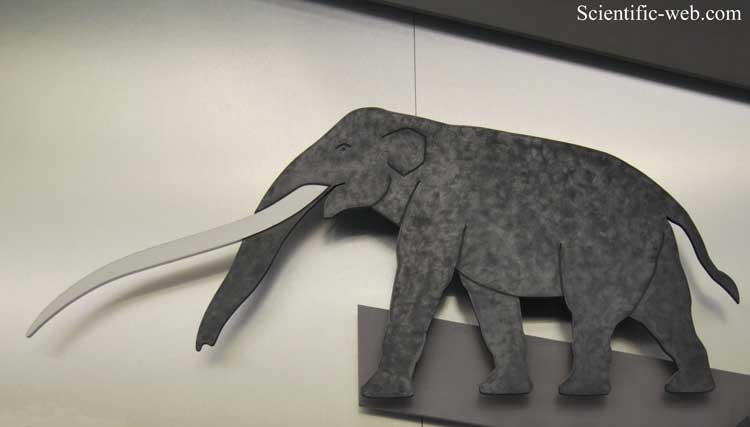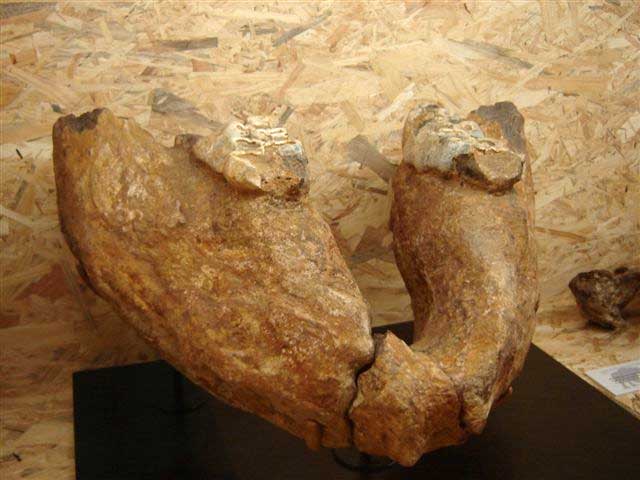
Anancus sp., Photo: Michael Lahanas
Superregnum: Eukaryota
Cladus: Unikonta
Cladus: Opisthokonta
Cladus: Holozoa
Regnum: Animalia
Subregnum: Eumetazoa
Cladus: Bilateria
Cladus: Nephrozoa
Superphylum: Deuterostomia
Phylum: Chordata
Subphylum: Vertebrata
Infraphylum: Gnathostomata
Megaclassis: Osteichthyes
Cladus: Sarcopterygii
Cladus: Rhipidistia
Cladus: Tetrapodomorpha
Cladus: Eotetrapodiformes
Cladus: Elpistostegalia
Superclassis: Tetrapoda
Cladus: Reptiliomorpha
Cladus: Amniota
Cladus: Synapsida
Cladus: Eupelycosauria
Cladus: Sphenacodontia
Cladus: Sphenacodontoidea
Cladus: Therapsida
Cladus: Theriodontia
Cladus: Cynodontia
Cladus: Mammaliaformes
Classis: Mammalia
Subclassis: Trechnotheria
Infraclassis: Zatheria
Supercohort: Theria
Cohort: Eutheria
Magnordo: Epitheria
Superordo: Afrotheria
Cladus: Paenungulata
Ordo: Proboscidea
Subordo: Elephantiformes
Cladus: Elephantimorpha
Cladus: Elephantida
Familia: †Gomphotheriidae
Genera: †Anancus
Species:
Name
Anancus

The jaw of Anancus, an extinct gomphotheriid elephant.
Vernacular names
中文: 互棱齿象属
Anancus is an extinct genus of elephantoid proboscidean native to Afro-Eurasia, that lived from the Tortonian stage of the late Miocene until the genus' extinction during the early Pleistocene, roughly from 8.5–2 million years ago.
Taxonomy
Restoration
The type genus of the family, Anancus, was named by Auguste Aymard in 1855. It was traditionally allocated to Gomphotheriidae, but was later assigned to the family Elephantidae by McKenna and Bell (1997), Lambert and Shoshani (1998), Kalb and Froelich (1995), and Shoshani and Tassy (2005). Hautier et al. (2009) assigned the genus to the subfamily Anancinae within Gomphotheriidae.[1] Recently Anancus along with other tetralophodont gomphotheres have been removed from Gomphotheridae, and are now regarded as members of Elephantoidea instead.[2][3][4]
Description
Anancus arvernensis
Anancus stood around 3 metres (9.8 ft) tall, with a weight up to 5 tons, and closely resembled a modern elephant.[5] Aside from its somewhat shorter legs, Anancus was also different from modern elephants in that its tusks were much longer, up to 4 metres (13 ft) in length.[6] The tusks were possibly defense weapons, not unlike elephants of today.[7][8] The molars were not composed of lamellae like those of true elephants, but had cusps, like tapir and pig molars; Anancus appears to have lived in forests, eating from trees and shrubs and digging out tubers and roots in the forest floor, and it died out when these forests gave way to grasslands.[6] Stable carbon isotopes from Ethiopian Anancus tooth enamel 3–4 million years ago suggest that it grazed on C4 plants.[9]
Evolutionary history
The oldest known species of Anancus is A. perimensis, with fossils known from the Tortonian ~ 8.5 million years ago Siwalik Hills of Pakistan. Anancus entered Europe approximately 7.2 million years ago and around 7 million years ago dispersed into Africa. Anancus first appeared in China around 6 million years ago (A. sinensis). Anancus disappeared from Asia and Africa around the end of the Pliocene, approximately 2.6 million years ago. The European A. arvernensis was the last surviving species, becoming extinct during the Early Pleistocene, around 2 million years ago.[10]
References
Hautier, Lionel; Mackaye, Hassane Taisso; Lihoreau, Fabrice; Tassy, Pascal; Vignaud, Patrick; Brunet, Michel (March 2009). "New material of Anancus kenyensis (proboscidea, mammalia) from Toros-Menalla (Late Miocene, Chad): Contribution to the systematics of African anancines". Journal of African Earth Sciences. 53 (4–5): 171–176. Bibcode:2009JAfES..53..171H. doi:10.1016/j.jafrearsci.2009.01.003.
Shoshani, Jeheskel; Tassy, Pascal (January 2005). "Advances in proboscidean taxonomy & classification, anatomy & physiology, and ecology & behavior". Quaternary International. 126–128: 5–20. Bibcode:2005QuInt.126....5S. doi:10.1016/j.quaint.2004.04.011.
Shoshani, J.; Tassy, P. (1996). "Summary, conclusions, and a glimpse into the future". In Shoshani, Jeheskel; Tassy, Pascal (eds.). The Proboscidea: Evolution and Palaeoecology of Elephants and Their Relatives. Oxford University Press. pp. 335–348. ISBN 978-0-19-854652-8.
Mothé, Dimila; Ferretti, Marco P.; Avilla, Leonardo S. (12 January 2016). "The Dance of Tusks: Rediscovery of Lower Incisors in the Pan-American Proboscidean Cuvieronius hyodon Revises Incisor Evolution in Elephantimorpha". PLOS ONE. 11 (1): e0147009. Bibcode:2016PLoSO..1147009M. doi:10.1371/journal.pone.0147009. PMC 4710528. PMID 26756209.
http://donsmaps.com/mastodon.html Mastodons and related early elephants
Palmer, D., ed. (1999). The Marshall Illustrated Encyclopedia of Dinosaurs and Prehistoric Animals. London: Marshall Editions. p. 241. ISBN 1-84028-152-9.
The Free Dictionary: Tusks
Upali.ch Elephants in Zoo and Circus, Teeth, second dentition, tusks.
Levin, Naomi E.; Haile-Selassie, Yohannes; Frost, Stephen R.; Saylor, Beverly Z. (6 October 2015). "Dietary change among hominins and cercopithecids in Ethiopia during the early Pliocene". Proceedings of the National Academy of Sciences. 112 (40): 12304–12309. Bibcode:2015PNAS..11212304L. doi:10.1073/pnas.1424982112. PMC 4603467. PMID 26371308. S2CID 205272461.
Konidaris, George E.; Roussiakis, Socrates J. (2018-11-02). "The first record of Anancus (Mammalia, Proboscidea) in the late Miocene of Greece and reappraisal of the primitive anancines from Europe". Journal of Vertebrate Paleontology. 38 (6): e1534118. doi:10.1080/02724634.2018.1534118. ISSN 0272-4634.
Benes, Josef (1979). Prehistoric Animals and Plants. Prague: Artua. p. 263.
Retrieved from "http://en.wikipedia.org/"
All text is available under the terms of the GNU Free Documentation License

